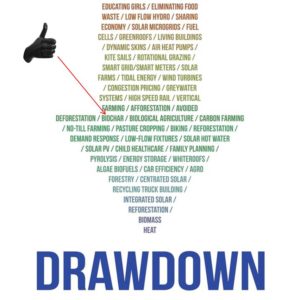Finally, finally, after what seemed like months, the recently debuted book ‘Drawdown: The Most Comprehensive Plan Ever Proposed to Reverse Global Warming’ became available on my library wish list. I was eager to pick it up and dive in, especially after having heard the author speak on a recent ‘Wonder Women Webinar’.
So far, and I confess I’ve only spent a few hours perusing; the book is both fascinating and frustrating. It is hope-filled yet distinctly lacking in details and references. Beautiful as any coffee table book could hope to be, yet strangely ordered for a logical thinker like me. The world definitely needs more hopeful books like this that provide potential solutions. But for a book titled ‘Drawdown’, at first blush the book seems to conflate reducing or replacing current bad habits (i.e. drawing down current emissions by avoiding fossil fuel technologies), which is critical but not enough to avoid climate chaos, with rebalancing and removal strategies (i.e. drawing down atmospheric CO2 levels via photosynthesis, sequestration etc.). While both are obviously needed – a point which they admit, to compare avoidance and removal strategies as equals seems overly simplistic. If drawdown is the goal and the book states that reversing global warming is the only goal that makes sense for humanity, than strategies capable of rebalancing and removing carbon (and other GHGs) ought to be weighed or at least categorized differently than those that can (only) avoid and reduce.
It is great that so much time and energy was spent explaining different technologies and strategies in a manner which nearly anyone can understand (even Grandma!) and providing some historical context for many of them was helpful. Yet the impact information – the most important criteria for rankings – is woefully insufficient; a single small paragraph amidst the one or two pages each solution was permitted, with no methodology, no assumptions, and for 20 – 25% of the solutions no cost or net savings information was provided. Drawdown rankings are based only on the GHG emissions that can be avoided or removed, so in this simplistic scenario such information may not seem relevant.
However there are many critical adoption issues which must be factored into any realistic plan for reversing global warming as these are what will ultimately determine which strategies soar and which sour. Some factors to consider include: current viability – are the solutions market ready or still on the drawing board; degree of difficulty in deploying quickly and broadly; financing availability and interest in various solutions; current or alternative options and the required infrastructure or operating costs and how those might prevent large scale adoption of more climate friendly options (e.g. natural gas versus heat pumps); regulatory helpfulness or hindrances for certain technologies; and which solutions offer other co-benefits (e.g. satisfying different UN SDGs) besides GHG mitigation which might make them more attractive in terms of funding as compared to options that only provide one primary benefit. No doubt there are many other considerations.
Since I normally blog about biochar, I would be remiss if I didn’t address their coverage of biochar, which they rank as #72 with a drawdown potential of .82 Gigatons of reduced CO2. The author of this section, like many people, conflates the meaning of Terra Preta with biochar. While the two are related, they are not the same; the latter is but one element of the former. They also state “The preferred method is gasification, a higher temperature pyrolysis that results in more completely carbonized biomass.” Gasification and pyrolysis are not the same; the former involves limited oxygen while the later is a no oxygen thermochemical conversion process. The two technologies can produce very different biochars, yields and co-products and both can be done using high temperatures. They also say “The slower the burn, the more biochar.” Generally speaking it is not the duration of the burn but rather the temperature of the burn that impacts yield the most (higher temps generate lower yield). There are other details that show a lack of deep understanding of the nuances of biochar, which could have easily been corrected had they reached out to one of many biochar experts. While they do a decent overall job describing biochar (albeit limiting it to a soils only perspective), what I think is really unfortunate is the carbon math. As I’ve already said the book is light on details so it is impossible to understand the parameters for their calculation of biochar’s drawdown potential, but I would guess they’ve only looked at a limited type of biomass and then looked only at sequestration capability and excluded the off-setting impact of other co-products (e.g. renewable heat or electricity) or reduction of GHG impacts which varies depending on the end use of the char (e.g. reduction of soil GHG emissions, reduction of GHG related to fertilizer production, or CH4 from livestock emissions if used as a feed additive).
As a means of starting a productive dialogue for climate change mitigation, I think Drawdown is great. As ‘the most comprehensive plan ever proposed to reverse global warming’ I can’t say the same. Drawdown is a sumptuous buffet of hopeful possibilities, but it cannot accurately be called a plan. The ranking of potential solutions has more in common with Fortune’s 100 Best Companies listing – except Fortune’s methodology is broader and more transparent. Perhaps Drawdown will evolve into something like this type of list, with annual updates and methodology refinements which not only show progress but serves to inspire the best kind of competition amongst those rising up to head off climate catastrophe.


